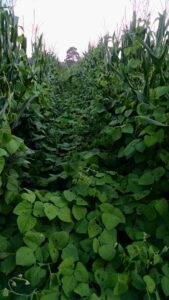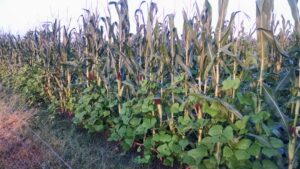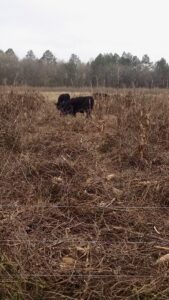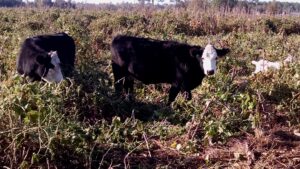2016 Annual Report for FS14-278
Grazing Standing Corn and Climbing Beans
Summary
During the week of April 25, 2015, three acres were planted with corn and climbing beans. The corn variety was Dixie 20. This variety was chosen because it is known for good stalk strength and because it was a non-Roundup Ready variety (this trait was not necessary since it was a mixed stand). Velvet bean seed were hard to find during the spring of 2015. The University of Georgia seed lab donated some seed for this project, however, the germination rate was very low. These seed were used, however, the majority of the plot was planted in lablab to make up for the low germination of the velvet beans. Rows were on a 36″ spacing. Two rows were planted with corn and two rows with beans in an alternating pattern. Fertilizer was applied at the recommended rate for corn. The field was cultivated once for weed control. After the corn was about 18″ tall, ammonium nitrate was applied at the recommended rate and the stand was “laid by”.
Adequate rainfall was received during the growing season and the corn and beans developed well. The velvet beans that germinated produced seed in late September. The lablab did not flower until early November and did not produce any seed. This could have been due to too much nitrogen.
Seven head of beef cattle with calves along with four goats were strip/limit grazed on the plot beginning on November 1. Each week, the strip wire was moved up approximately 10 yards. By limit grazing, the animals were able to graze the plot until early February. Cattle were fed their normal ration of free access bermudagrass hay during this time and were given supplemental whole cottonseed beginning December 20.




Objectives/Performance Targets
The first objective was to determine how many hours of labor were needed to strip graze cattle on corn/climbing beans and how does this compare with the amount of labor to purchase and feed commercial feed. I found that by grazing the corn and beans, my labor was decreased during November and December. Grazing the corn and beans reduced the amount of hay fed during this time and no supplementation was given until nearly the end of December. I would estimate that 1-2 hours/per week were saved during this time.During January, there was no significant reduction in labor as supplemental feeding of whole cottonseed was done during this month.
The second objective was to make a cost comparison between the corn/climbing beans versus traditional hay and supplementation. Simply using the costs of hay and supplementation. Looking at only hay and supplemental feed, the winter cost per cow decreased by approximately 50% by utilizing the corn and beans. This was due to a decrease in the amount of hay and supplemental feed needed. However, when the cost of planting and growing the corn/beans is factored in, the winter cost/cow was about the same.
The third objective was to determine how much nitrogen was added back to the soil after the first season. Soil tests have been submitted to the University of Georgia and results are pending.
The fourth objective of the study was to determine if grazing standing corn and climbing beans would maintain body condition on the cattle. Although the cattle did not improve in body condition, average body condition was maintained during the first two months of the study. It should be noted that the all seven females calved during November and body condition decreased 1-2 points on three of the cows during the last month of the study (it should be noted that these three were first-time heifers and thus had higher nutritional requirements from the average cow).
Accomplishments/Milestones
Although I am only one year into this two year project, I believe the project has been successful thus far. I made notes based on the planting rates and spacing and look forward to trying different approaches in 2016. I was also able to obtain Velvet Bean seed from Petcher Seeds for the 2016 season and will be able to compare this with the Lablab used in 2015. Although not an objective of the study, it is visually apparent that this method has increased the organic matter in my soil.
Impacts and Contributions/Outcomes
I was well pleased with the first year of this project. I believe that my labor was reduced and cattle body condition was maintained. I further note that expense of wintering my cattle held steady.
One negative point that has not been addressed, though, is that this type of system takes land out of production during the warm season. On my farm, three acres was set aside for this project. This study does not address the lack of grazing this land from April-October.
Additionally, several neighbors took note of this grazing project since the stand is near the highway. These neighbors have already decided to try this type of grazing scenerio with their own herds.
Collaborators:
Executive Secretary
Georgia Young Farmers Association
2802 Moore Hwy, ABAC 34
Tifton, GA 31793
Office Phone: 2293863429
County Extension Agent
UGA Cooperative Extension Service
3225 Harris Road
Waycross, GA 31503
Office Phone: 9122872456
South Region Animal Science Teacher
Georgia Agriculture Education
2802 Moore Hwy, ABAC 34
Tifton, GA 31793
Office Phone: 2293863428